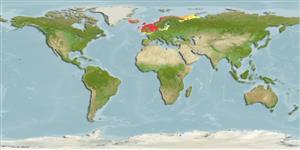Environment: milieu / climate zone / depth range / distribution range
Écologie
marin; saumâtre benthopélagique; profondeur 10 - 150 m (Ref. 35388), usually 10 - 150 m (Ref. 35388). Temperate; 73°N - 49°N, 54°W - 60°E
Northeast Atlantic: 74°N (Novaya Zemlya and Bear Islands) to 49°N (Channel Islands, western English Channel), including eastern Greenland, Iceland, Barents Sea (but not the White Sea) and the Baltic (but not the Gulf of Bothnia and Finland).
Length at first maturity / Taille / Poids / Âge
Maturity: Lm ?, range 11 - ? cm
Max length : 25.0 cm TL mâle / non sexé; (Ref. 232); âge max. reporté: 10 années (Ref. 35388)
Description synthétique
Morphologie | Morphométrie
Épines dorsales (Total): 0; Rayons mous dorsaux (Total): 56-63; Rayons mous anaux: 29 - 33. Scales absent from a median band anterior to the dorsal fin and from the musculature at the base of caudal fin. Belly scales loosely arranged, not in chevrons. Vertebrae 65-75. Margins of dorsal and anal fins straight with rays of equal length. Lateral line pores linearly arranged along the unbranched canals.
This schooling species is usually territorial and burrowing (Ref. 40). Feed on plankton. High activity is correlated to periods with strong tidal currents; then they leave their bottom hides and form large shoals. During low light intensity (night and winter) they bury in the bottom (Ref. 35388).
Muus, B.J. and J.G. Nielsen, 1999. Sea fish. Scandinavian Fishing Year Book, Hedehusene, Denmark. 340 p. (Ref. 35388)
Statut dans la liste rouge de l'IUCN (Ref. 130435)
Menace pour l'homme
Harmless
Utilisations par l'homme
Pêcheries: commercial
Plus d'informations
RéférencesAquacultureProfil d'aquacultureSouchesGénétiqueElectrophoresesHéritabilitéPathologiesTraitementNutrientsMass conversion
Outils
Articles particuliers
Télécharger en XML
Sources Internet
Estimates based on models
Preferred temperature (Ref.
123201): 6.7 - 11, mean 9.7 °C (based on 1058 cells).
Phylogenetic diversity index (Ref.
82804): PD
50 = 0.5156 [Uniqueness, from 0.5 = low to 2.0 = high].
Bayesian length-weight: a=0.00275 (0.00205 - 0.00370), b=3.14 (3.07 - 3.21), in cm total length, based on LWR estimates for this species (Ref.
93245).
Niveau trophique (Ref.
69278): 3.3 ±0.40 se; based on food items.
Résilience (Ref.
120179): Milieu, temps minimum de doublement de population : 1,4 à 4,4 années (K=0.16-0.89; tm=1-3; tmax=10; Fec=4,000).
Fishing Vulnerability (Ref.
59153): Low to moderate vulnerability (30 of 100).
Nutrients (Ref.
124155): Calcium = 44.2 [24.8, 86.8] mg/100g; Iron = 0.34 [0.20, 0.60] mg/100g; Protein = 18.6 [17.2, 19.8] %; Omega3 = 0.448 [0.217, 0.891] g/100g; Selenium = 14.2 [5.9, 30.8] μg/100g; VitaminA = 36.1 [12.4, 109.0] μg/100g; Zinc = 0.825 [0.582, 1.152] mg/100g (wet weight);
